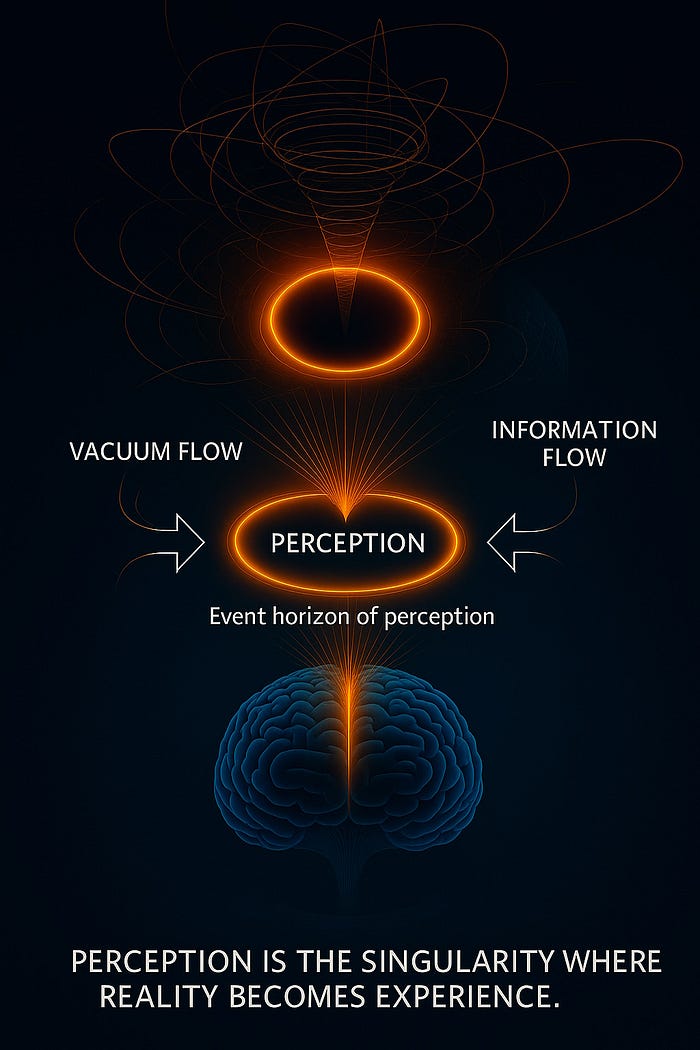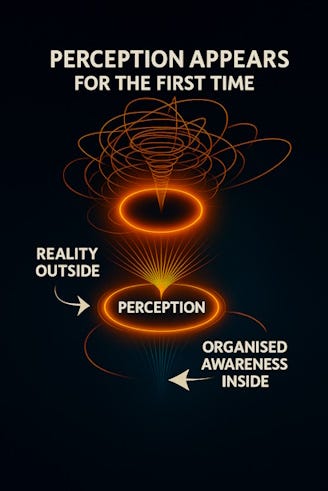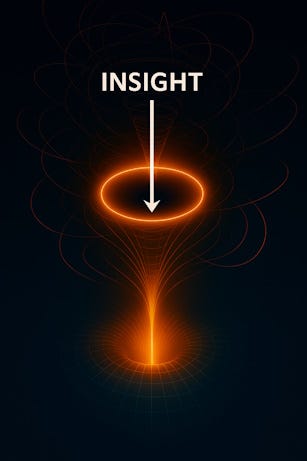
Perception is not something that happens inside the brain, nor is it a photograph of the outside world. It is a meeting point, a boundary where the world and awareness touch without fully becoming one another. At this boundary, something new appears — neither purely matter nor purely mind, but experience. Light does not become sight until it crosses this horizon. Sound does not become hearing until it enters awareness. Perception is this crossing.
It is often imagined that perception is a copy of the world stored inside the brain. But nothing is copied. There is no image inside the skull, no little screen on which reality is projected. What exists are electrical impulses, fields of activity, and flows of energy. Yet somehow, there is colour, texture, distance, sound, taste, pressure, warmth. These do not exist out there in the world, nor in the brain’s circuitry alone. They exist at the very point where the world and the brain meet and generate awareness.

Perception begins as raw information — photons striking the eye, air vibrating against the eardrum, molecules touching the nose or tongue, pressure forming on the skin. But perception itself is not in these signals. It appears only when those signals are shaped by attention, when they are gathered into coherence by the brain and allowed to touch silence within. It is not what enters the senses that matters — it is what crosses into awareness.

This is why perception feels so immediate, so intimate. It is not distant, like an idea about the world. It is the world arriving within. Yet perception is not fully the world, nor fully the self. It is a threshold — a singularity of experience. In physics, a singularity is a point where the usual rules break down, where something infinite touches something finite. Perception is like this. The infinite complexity of the world meets the finite structure of the brain, and out of that tension arises experience.
When the mind is agitated — filled with thought, memory, fear, projection — this horizon becomes clouded. Perception bends inward, shaped more by expectation than by reality. We do not see what is, but what the mind allows. It is like looking through water rippling in the wind. The world arrives broken, fragmentary. But when the mind becomes still, perception clears. Like a lake without wind, it reflects the world as it is, without distortion. In this stillness, there is no gap between the seer and the seen, the listener and the sound. There is only perception itself — effortless, precise, whole.
At such moments, perception feels less like something we do and more like something that happens through us. Awareness opens, and the world flows in. The boundary between inner and outer grows thin. The tree is simply seen, the sound is simply heard — without naming, without judgement. Thought may come later, but perception arrives first, pure and indivisible. It is the foundation of all knowing.
To understand perception in this way is to recognise its structure. It moves like a torus, like a vortex. Information flows inward — from the world into the senses, into the nervous system, into awareness. Then it flows outward again — as meaning, emotion, response, action. This is not a straight line from object to brain. It is a loop — a continuous circulation. Inward sensing, outward expression. World to awareness to world again.
This flow is not so different from what we see in nature elsewhere. A proton holds the vacuum in a stable vortex, creating mass. A galaxy spins around a centre, holding stars in motion. A cell holds chemistry in a membrane, creating life. The mind holds awareness at a boundary, creating experience. It is the same gesture across scales — the universe folding into form, and unfolding again into movement.
In this sense, perception is not passive. It is not a window. It is an active shaping of the world into knowable form. The world offers itself as a possibility; the mind offers structure. Between them, perception appears — alive, dynamic, changing every moment.
Insight is simply perception without interference. When the mind is quiet enough, reality enters directly, without distortion. It is not pulled into memory or pushed into analysis. It is seen. And in that seeing, something new can emerge — understanding, meaning, direction. Insight is not produced by thought. It arrives when thought steps aside.

This is why silence matters — not as absence of sound, but as absence of noise in the mind. In silence, awareness becomes like a clear lens. Perception sharpens. The event horizon of the mind becomes smooth. Reality flows in without resistance. And from that, meaning is born — not from effort, but from contact.
Perception, then, can be seen as a singularity — not because it is violent or destructive, but because it is where two infinities meet: the external infinity of the universe, and the internal infinity of awareness. Where they touch, experience appears. Where they dance, life becomes conscious. And where this touching is undisturbed, the universe recognises itself.
Perhaps this is all perception truly is — the universe folding itself into awareness through a human being. First as matter, then as life, and finally as experience. Not something owned, not something created by thought — but something happening now, in this very moment, as the world becomes conscious of itself through the quietness of a mind that is able to see.
